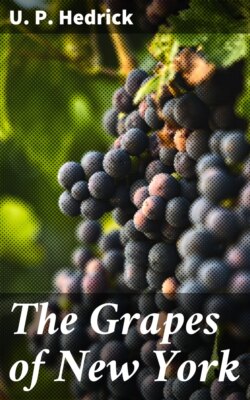Читать книгу The Grapes of New York - U. P. Hedrick - Страница 21
На сайте Литреса книга снята с продажи.
3. VITIS RUPESTRIS Scheele.
ОглавлениеTable of Contents
1. Scheele, Linn., 21:591. 1848. 2. Ravenel, U. S. Pat. Off. Rpt., 1859:539. Mountain grape of Texas. 3. Buckley, Ib., 1861:485. Rock grape. 4. Prince, Gar. Mon., 5:73. 1863. Bush grape of Texas. 5. Engelmann, Mo. Ent. Rpt., 1872:61. Sand grape; Sugar grape. 6. Jaeger, Mo. Hort. Soc. Rpt., 1883:41. 7. Engelmann, Bush. Cat., 1883:10, 11, 12, 14, 18. Rock grape; Sand grape; Sugar grape. 8. Bush, Ib., 1883:21, 26. 9. Munson, Am. Hort. Soc. Rpt., 1885:132. Sand-beach grape; Sugar grape. 10. Campbell, Am. Pom. Soc. Rpt., 1885:84. 11. Munson, Ib., 1885:97, 98. 12. Ib., Soc. Prom. Ag. Sci. Rpt., 1887:59. Sugar grape; Sand grape; Beach grape. 13. Planchon, De Candolle’s Mon. Phan., 5:323, 346. 1887. Sand grape; Sugar grape; Mountain grape. 14. Munson, Gar. and For., 3:474. 1890. 15. Ib., U. S. D. A. Pom. Bul., 3:7, 9. 1890. 16. Ib., Am. Gard., 12:659. 1891. 17. Ib., Mich. Hort. Soc. Rpt., 1893:116. Rock grape; Sand grape. 18. Munson, Bush. Cat., 1894:20, 22. 19. Husmann, 1895:110, 188. 20. Britton and Brown, 2:411. 1897. Sand grape; Sugar grape. 21. Bailey, Gray’s Syn. Fl., 1:421. 1897. Sand grape; Sugar grape; Rock grape; Bush grape; Mountain grape. 22. Beach, N. Y. Sta. An. Rpt., 17:537, 557. 1898. 23. Munson, Tex. Sta. Bul., 56:234, 235, 239, 259. 1900. Rock grape. 24. Viala and Ravaz, Am. Vines, 1903:42, 82.
Small, much branched shrub or sometimes, under favorable circumstances, slightly climbing. Diaphragm thin but slightly thicker than Riparia; tendrils few, or, if present, weak, usually deciduous. Leaves rather small; young leaves frequently folded on midrib; broadly cordate or reniform, wider than long, scarcely ever slightly lobed, smooth, glabrous on both surfaces at maturity; petiolar sinus wide, shallow; margin rather coarsely toothed, frequently a sharp abrupt point at terminal. Cluster small. Berries small, usually larger than Riparia, color black or purple-black. Seeds small, not notched; beak short, rather blunt; raphe slightly distinct to indistinct, usually showing as a narrow groove; chalaza of medium size, pear-shaped, sometimes distinct, but usually a depression only. Leafing, blossoming, and ripening early (blossoming soon after Riparia).
Rupestris seems to have been first described and named by Scheele in 1848 in a contribution on the flora of Texas to the periodical Linnaea. Ravenel, in 1859, states that this grape is found in Texas and is there known as the Mountain grape. It was mentioned and described by Buckley, Engelmann, and all of the later botanists. (See Plate.)
This species is an inhabitant of southwestern Texas, extending eastward and northward into New Mexico, southern Missouri, Indiana and Tennessee to southern Pennsylvania and the District of Columbia. Its favorite places are gravelly banks and bars of mountain streams or the rocky beds of dry water-courses. Rupestris is usually considered drouth-resistant but Munson states that it is short-lived in the upland sandy soils in northern Texas, where, owing to long droughts, the land dries out deeply. Here, he says, it is not so successfully resistant to drouth as Lincecumii.[130]
This species is quite variable both in type and growth. It was introduced into France at about the same time as Riparia, and the French vineyardists selected the most vigorous and healthy forms for grafting stock. These pass under the various names of Rupestris Mission, Rupestris du Lot, Rupestris Ganzin, Rupestris Martin, Rupestris St. George, and others. In France they are stated to have given particularly good results on bare, rocky soils with hot, dry exposures. In California, Husmann[131] states, “It does not flourish in dry locations here, and as it suckers profusely and does not take the graft as readily as the two former classes [Riparia and Aestivalis], it is not largely propagated.” It has not been sufficiently cultivated in this country east of the Rocky Mountains so that it can be said what conditions of soil and climate best suit this species other than the general conclusions that may be drawn from the conditions present where the species is indigenous.
RUPESTRIS DU LOT
The clusters of fruit are small, with berries about the size of a currant and varying from sweet to sour. The berry is characterized by much pigment under the skin. The fruit has a sprightly taste wholly free from any disagreeable foxiness. According to Munson, it is too unproductive to be profitable. The sugar and acid content of the must is not known. Jaeger states that Rupestris wine sent to France was there judged as decidedly the best American claret yet tested.
Rupestris under cultivation is said to be very resistant to rot and mildew of the foliage. It is considered hardy by those familiar with it in the Southwest, and Campbell states that it withstood, without injury, 32 degrees below zero at Delaware, Ohio. The attention of hybridizers was attracted to this species over thirty years ago and various hybrids have been produced by Jaeger, Munson, Campbell and Millardet, all of whom considered Rupestris of great promise for grape-breeding. The root system of Rupestris is peculiar in that the roots penetrate at once deeply into the ground instead of extending laterally as in other species. Like those of Riparia, the roots are slender, hard, and resistant to the phylloxera. The species is easily propagated by cuttings. According to Husmann[132] the vines bench-graft readily but are difficult to handle in field grafting.
